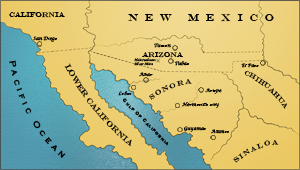The Places
Related Documents
- Homeland Maps
- Aravaipa Canyon Photo
- Map of Arizona and Silver Mines
(Beinecke Manuscript & Rare Book Library)
To outsiders, the desert landscape of the U.S.-Mexico borderlands could appear strange, even foreboding. Rainfall in some parts of the Arizona-Sonora region averaged no more than four inches per year, far less than the twelve inches necessary to raise most crops. Those streams of water that did exist often vanished underground for miles at a stretch. And instead of the forests of leafy trees found in more temperate regions, one encountered instead numerous spiny cacti, the most striking being the towering saguaro cactus (Cereus giganteus), which can grow to heights of fifty feet.
The saguaro is one of the defining features of the vast 120,000 square-mile Sonoran Desert. This desert, one of North America's largest and driest, takes its name from the Mexican state of Sonora, now located to the south of Arizona. Until 1853, however, Sonora's boundaries extended all the way to the Gila River. In this year the United States pressured Mexico's President Antonio López de Santa Anna to sell 30,000 square miles of northern Mexico to the United States for ten million dollars. Included in this sale were the villages of Tucson, Tubac, and San Xavier del Bac as well as Aravaipa Canyon and the future grounds of Camp Grant, all of which would be incorporated into the new territory of Arizona.
To many Americans at the time, this newly acquired region (which came to be known as the Gadsden Purchase after James Gadsden, the American minister who arranged its sale) seemed, in the words of one correspondent to the New York Times, "a dreary district" where "the land [was] bare, sandy, parched and sterile." What little value it did have was as a way to go somewhere else: one of the leading reasons for the region's purchase, in fact, was that it made possible a southern route for the U.S.'s proposed transcontinental railroad. To those already inhabiting the region in the 1850s, however, the so-called Gadsden Purchase represented not a road to elsewhere but instead a vision of home.










